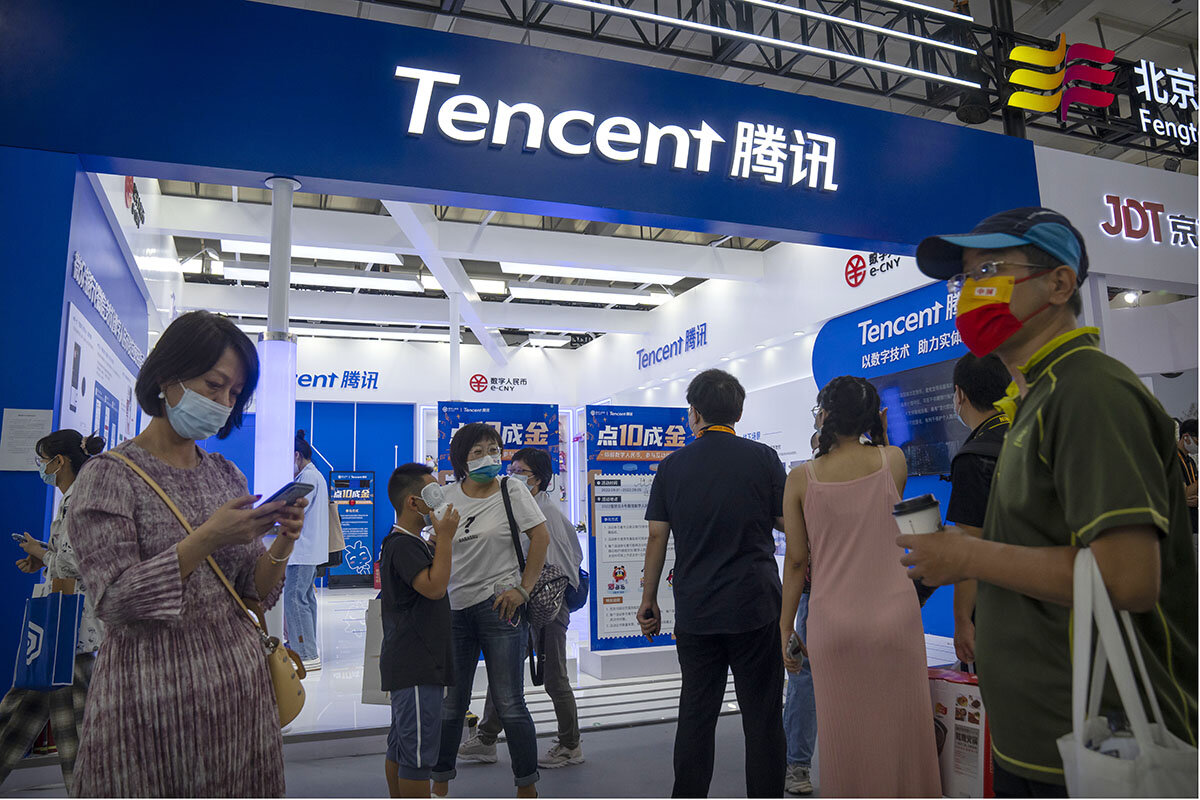Safety or stagnation? Why China’s isolationism may backfire.
Loading...
| Shanghai
One day in late August, shortly after China’s leaders reportedly gathered at the Bohai Sea resort of Beidaihe to put the finishing touches on the agenda for next week’s 20th Communist Party Congress, a government think tank posted an obscure academic article online, sparking a surprising debate.
The article challenged the mainstream view that the isolationism of China’s Ming (1398-1644) and Qing (1636-1912) dynasties severely weakened China, recasting the policies as targeted efforts to defend China’s territory and culture against “aggressive Western colonial forces.”
Chinese netizens and China watchers alike interpreted the article – unusual for having no named author – as a political bid to lend historical ammunition to Chinese leader Xi Jinping’s drive to make China more self-sufficient and fortify it against foreign threats.
Why We Wrote This
A story focused onChina’s increasingly isolationist policies stem from Xi Jinping’s dark view of the international landscape, and his belief that the only safe China is a self-sufficient China. But openness, experts say, is also a source of strength.
With Mr. Xi poised to gain a rare third term at the twice-a-decade political conclave that opens in Beijing on Sunday, a critical question is whether his emphasis on buttressing China will succeed in making it strong and autonomous – or instead deepen its isolation and bring economic stagnation.
Mr. Xi’s push for self-sufficiency has enormous implications for the rest of the world. China’s rise over the past 40 years was fueled by its market-oriented economic reforms and opening to trade, which unleashed the private sector and brought in foreign technology and investment. Now the top trading nation, China is the number one trade partner to more than 120 countries.
But since taking power in 2012, Mr. Xi has transformed China’s priorities. Mr. Xi’s approach is rooted in his darker view of the international environment compared with those of earlier Chinese leaders, experts say. In his eyes, China is besieged by “hostile foreign forces” bent on thwarting its rise and bringing about the party’s collapse. National security, Mr. Xi says, is China’s “top priority.”
“Xi places much greater emphasis on national security than he does on economic policy,” says Richard McGregor, senior fellow for East Asia at the Lowy Institute, an Australian foreign policy think tank.
China’s arch foe, in Mr. Xi’s view, is the United States – and he uses the rivalry to mobilize the party and silence internal critics, says Mr. McGregor. He says anyone who opposes Mr. Xi risks being “branded as disloyal and working against the motherland” as it faces “an epochal showdown with a rival superpower.”
Push toward self-reliance
Internally, Mr. Xi has moved aggressively to strengthen the Communist Party and tighten its grip over the economy and society. He’s subordinated the private sector to state-run firms and expanded industrial policy, using huge subsidies to try to outcompete the West in advanced technologies. His stringent COVID-19 controls have closed China’s borders to many foreign visitors while requiring all inbound travelers to quarantine.
To ensure China can fend for itself in a dangerous world, Mr. Xi seeks to make the country of 1.4 billion people self-reliant in food, energy, and advanced technology. His push for self-sufficiency has gained urgency with the U.S.-China trade war, tensions over Taiwan, and the sanctioning of Russia over its invasion of Ukraine, says Minxin Pei, professor of government at Claremont McKenna College.
“Before 2018 and the trade war, their goal was aspirational. Today, it is existential,” he says, adding that China’s leaders “have elevated self-sufficiency to a level China has not seen since the end of the Mao era” in 1976, prioritizing it as “an issue of national survival.”
Yet China’s inward turn toward state-led self-reliance under Mr. Xi – together with his strict COVID-19 policy – has come at a cost in economic vitality and innovation, experts say.
Mixed results
Under Mr. Xi, annual gross domestic product has steadily declined and this year is expected to fall to 3.5% – missing the government’s goal of 5.5% – according to the Bank of China.
More importantly, economists say, China’s total factor productivity – a key measure of efficiency – has declined from an average of 3.5% a year in the 2000s to 0.7% in the 2010s, according to the International Monetary Fund.
Technological innovation is central to Mr. Xi’s economic strategy, but by directing investment through the state-owned sector, which is less productive, efficient, and innovative, Beijing undermines that goal.
“China has a system that’s really good at mobilizing resources. But innovation, technological creativity, needs … a lot of flexibility, it needs a lot of openness,” says Dr. Pei. “That is the fundamental dilemma faced by the Chinese government.”
Mr. Xi’s plan for China to dominate key technologies on its own underestimates the importance of international collaboration in achieving breakthroughs in areas such as semiconductors, experts say.
“Every single success story is done through collaboration,” says Yasheng Huang, professor of international management at the MIT Sloan School of Management. “I think they are going to have a very humbling experience with semiconductors.”
To be sure, China has enjoyed successes in homegrown technology, and over the past 10 years it has risen to 11th among countries ranked in the Global Innovation Index published by the World Intellectual Property Organization, a U.N. agency in Geneva. Chinese officials and experts warn that foreign restrictions on technology transfers to China – such as the recent U.S. tightening of controls on semiconductor chip exports – will backfire and spur Beijing’s efforts at technological independence.
Tensions between China and the U.S., European countries, and other developed economies have grown during Mr. Xi’s tenure, as illustrated by sharply negative turns in public opinion toward his leadership. “Despite its attempts to build a new global order by courting other authoritarian regimes, and its trade and investment around the world, China has become more isolated from countries in the West,” says Anthony Saich, professor of international affairs at the Harvard Kennedy School.
Inside China, Mr. Xi retains significant backing, especially from China’s nationalists. His poverty alleviation and anti-corruption campaigns have been widely popular, and his health policies have succeeded in keeping China’s COVID-19 cases and deaths far lower than in many other countries.
The path ahead
Next week’s party congress and related political events are expected to endorse both Mr. Xi’s third term and his broad agenda of self-sufficiency.
“For Xi’s third term, the trends in the recent years’ Chinese economy seemingly will continue, primarily the emphasis on self-sufficiency” and “the state-owned sector’s expansion at the cost of the private sector,” says Wu Guoguang, senior research scholar at the Stanford Center on China’s Economy and Institutions at Stanford University.
But with no end in sight to Mr. Xi’s COVID-19 mandates, many Chinese worry that as they endure continuous tests and unpredictable lockdowns, their nation feels increasingly quarantined from the rest of the world.
Such concerns heightened the controversy over the recent academic article on Ming and Qing history, with its more positive reinterpretation of the ancient policy of “isolation and locking the country,” or bi guan suo guo, familiar to most Chinese from textbooks.
“The data are pretty clear that openness – both in history and contemporary periods – promotes economic growth and … technological development,” says Dr. Huang, who with colleagues in China has researched trends in Chinese inventiveness since ancient times.
In contrast, “the closed-door policy destroyed China’s economy,” says Dr. Huang, author of the forthcoming book “The Rise and Fall of the EAST: Examination, Autocracy, Stability and Technology in Chinese History and Today.”
Many Chinese posted comments online comparing China’s past isolationist policies with the zero-COVID-19 closures of today.
“Back then, the whole world was in full swing with the Industrial Revolution. We closed our country in isolation … fell behind and were beaten,” commented one person in Chinese on the popular Weibo microblogging website.
“The whole world is opening up,” wrote another, “and only we are locked away.”








